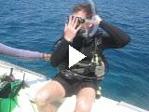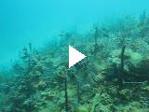As I had promised my friend Dennis, we arrived in the small tourist town of Placencia and set up our tents on the beach, planning to stay for a few days. We had one goal while in town: to see the coral reefs off Belize’s shore.
Coral reef ecosystems are some of the most diverse and interesting ecosystems in the world. Coral reefs consist of organisms that build hard calcium carbonate shells, known as ‘reefs’. These organisms house and protect algae, which form the basis of the coral reef ecosystem. The structures built by the corals also provide shelter for many different types of marine life, and coral reef ecosystems are extremely diverse. Over time, as the skeletons of reefs accumulate, the coral builds large underwater structures, making even islands (coral atolls) or ‘barrier reefs’ – long structures parallel to the shore. The largest of these barrier reefs is in Australia (the ‘Great Barrier Reef’), and the second largest is off the coast of Belize.
To see the reef close up, I took a SCUBA class. It felt strange paying as much for three days of SCUBA instruction as I paid for the entire month of February, but it was more than worth it, especially considering that these reefs may not survive this century. Dennis, who was already certified to SCUBA, joined me for my training dives, and we took a boat to the barrier reef with other vacationing Americans.
I was amazed by the amount of life in Belize’s reef. Having purchased an underwater case for my camera, I used all my memory cards almost immediately. At times I thought I was in an aquarium — huge schools of fish swam around us, eels weaved through the reef, lobsters hid in the reef, and long sponges rose above the ocean floor. (I have a number of high resolution movies that are too big to post on this site — you’ll have to wait till I return!)
These reefs are in trouble. Over 10% of reefs worldwide have already been destroyed, largely through changes in land use near the shore, which cause chemicals and excess nutrients to runoff into the ocean. This runoff can kill the delicate reefs. The reefs are also in danger from higher temperatures. When temperatures rise above a certain level, the algae in the reefs die, a phenomenon known as coral bleaching. In 1998, one of the hottest years on record, 16% of the world’s reefs were damaged by hotter temperatures. Some of these reefs survived, while others have not recovered. Higher temperatures will make coral bleaching more common, killing many reefs.
Reefs are also threatened by changing ocean chemistry. Much of the carbon dioxide that we add to the atmosphere is actually absorbed by the oceans. Carbon dioxide reacts with water to make carbonic acid, and, since the start of industrial times, the oceans have become more acidic by 0.1 pH. According to a professor who studies ocean chemistry in my former department at the Carnegie Institute of Washington (he also helped put together this lengthy report), the oceans may become too acidic for coral reefs to make their calcium carbonate shells. ‘Higher temperatures may not be the real problem,’ he told me before I left, ‘the reefs may simply dissolve.’
Coral reefs, such as the ones I swam by off the shore of Belize, are in great danger. Some reefs may survive global warming, but, without action, the majority of reef ecosystems around the world will likely collapse. These reefs are the most biologically diverse parts of the ocean, and without them, we will lose untold numbers of underwater species. These extinctions would be a tragedy not only in their own right, but also for fishermen, the tourism industry, and those of us who enjoy visiting these underwater jungles.









